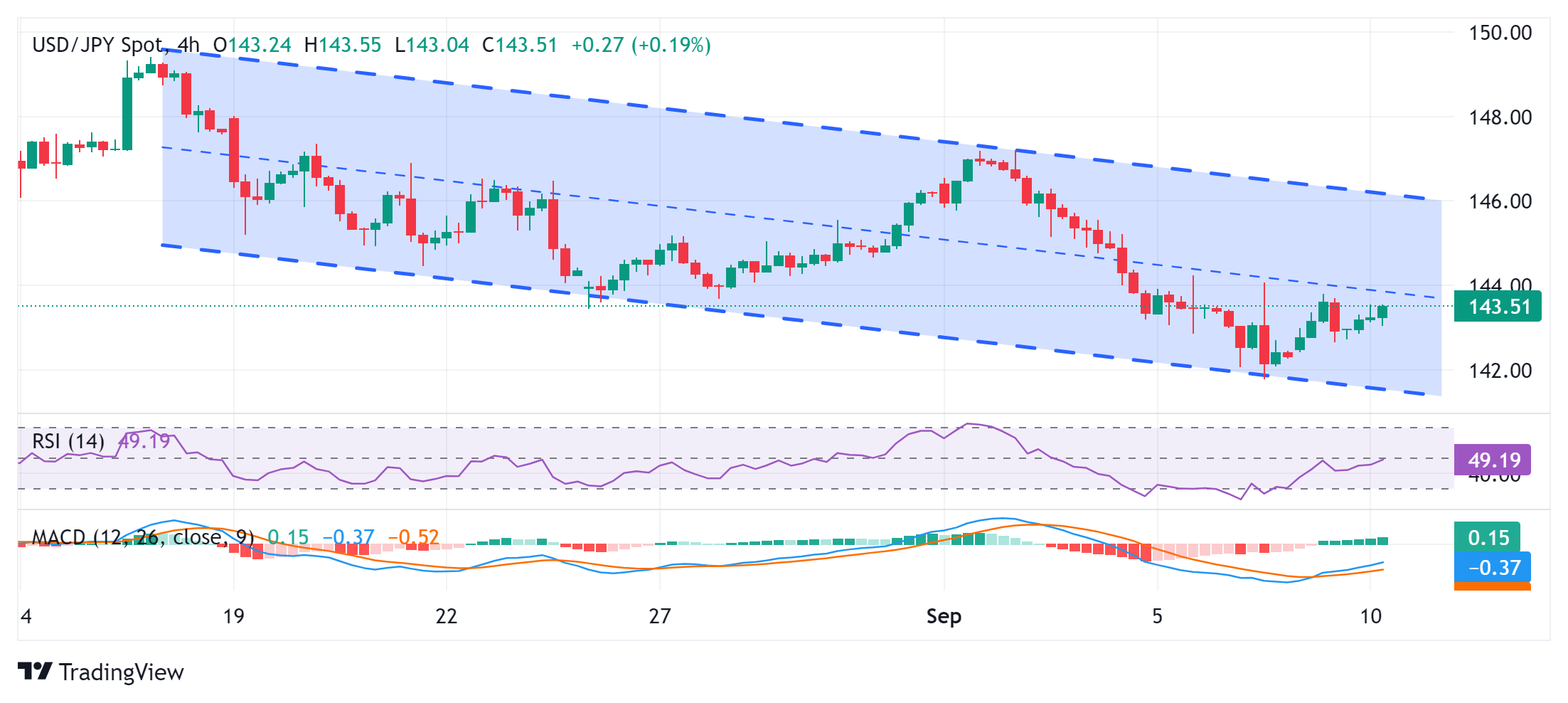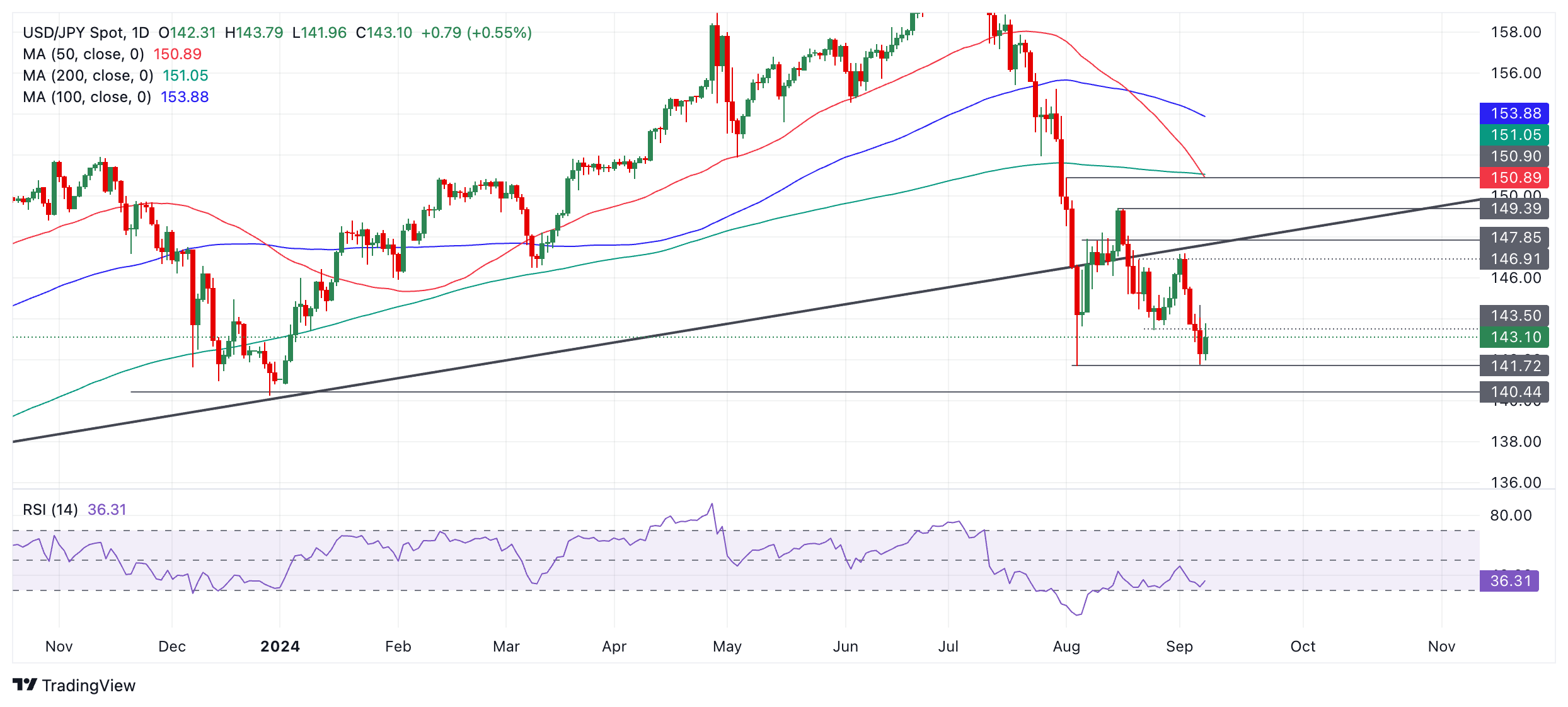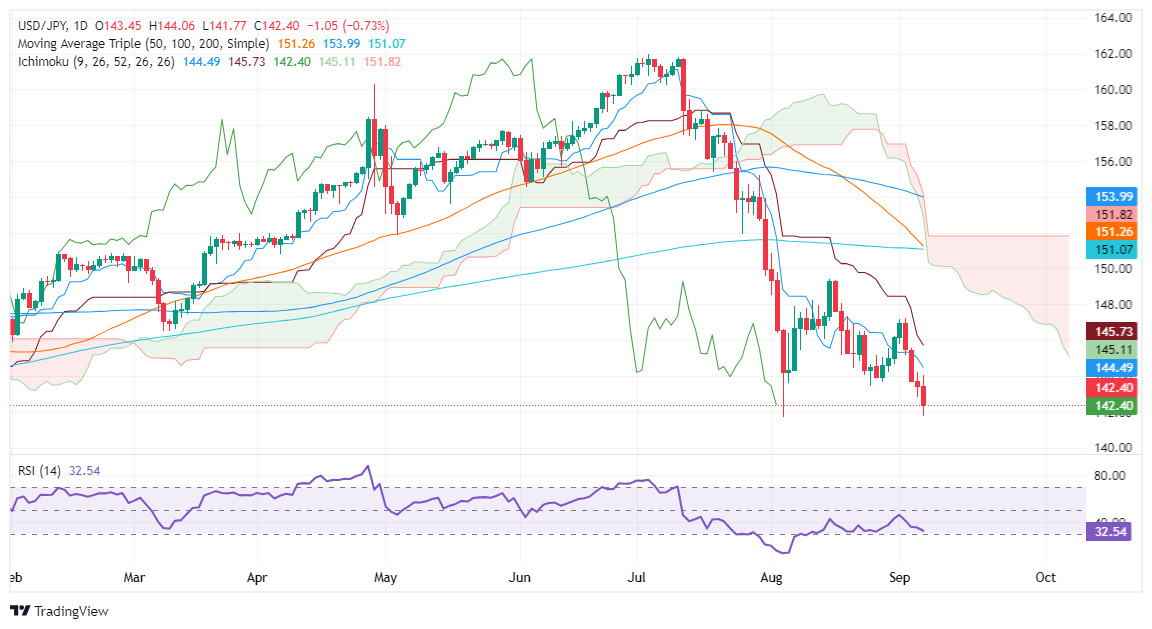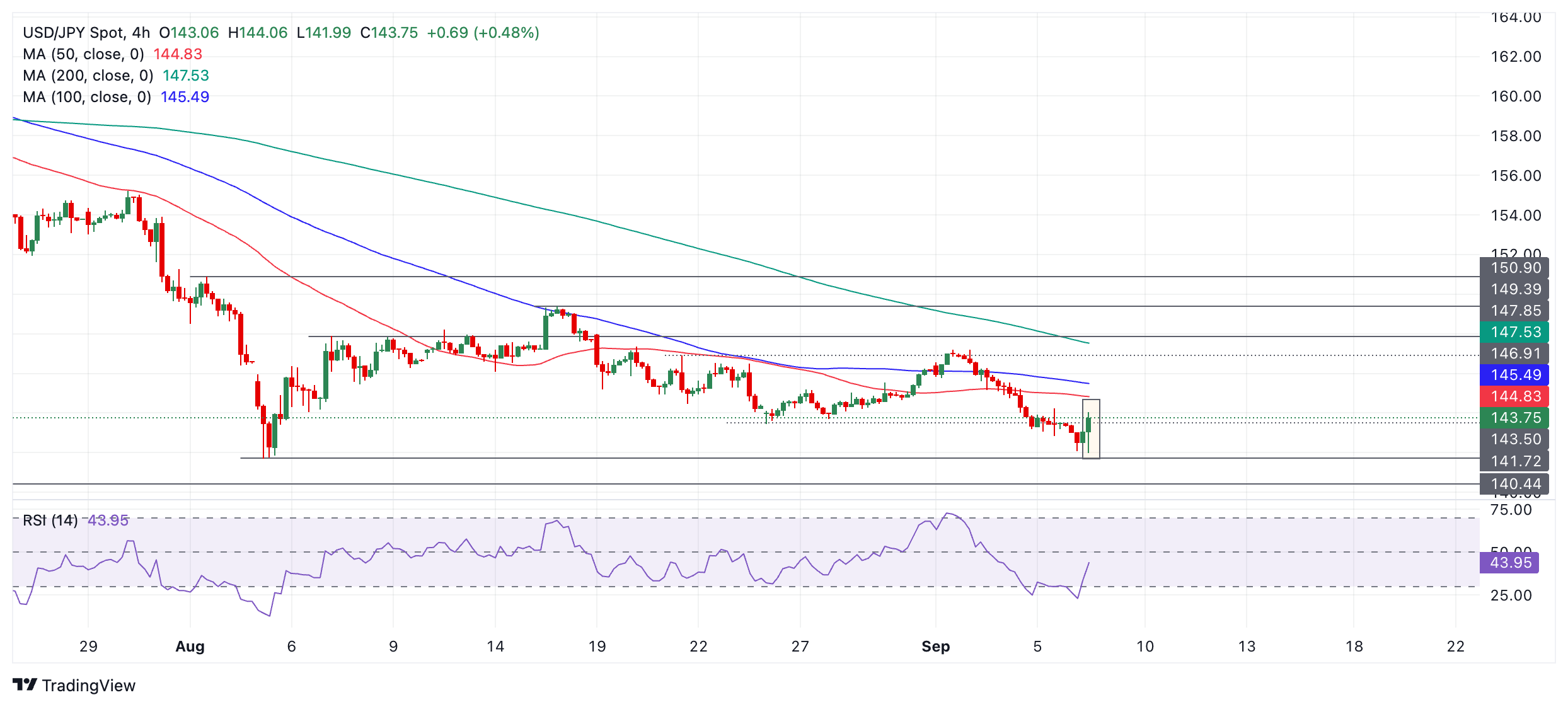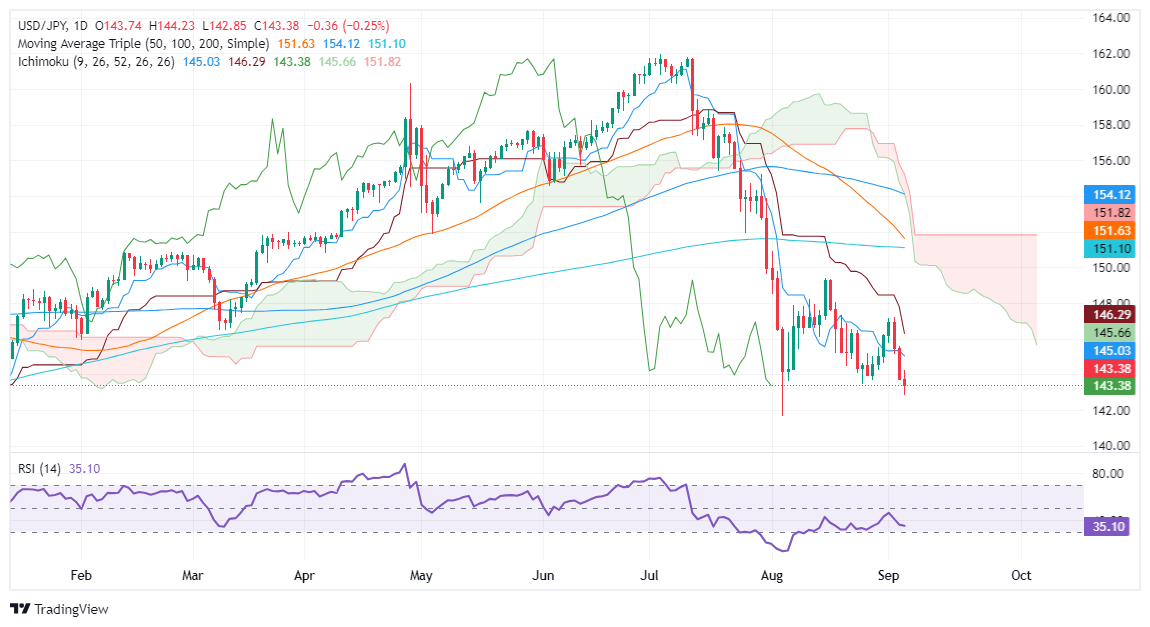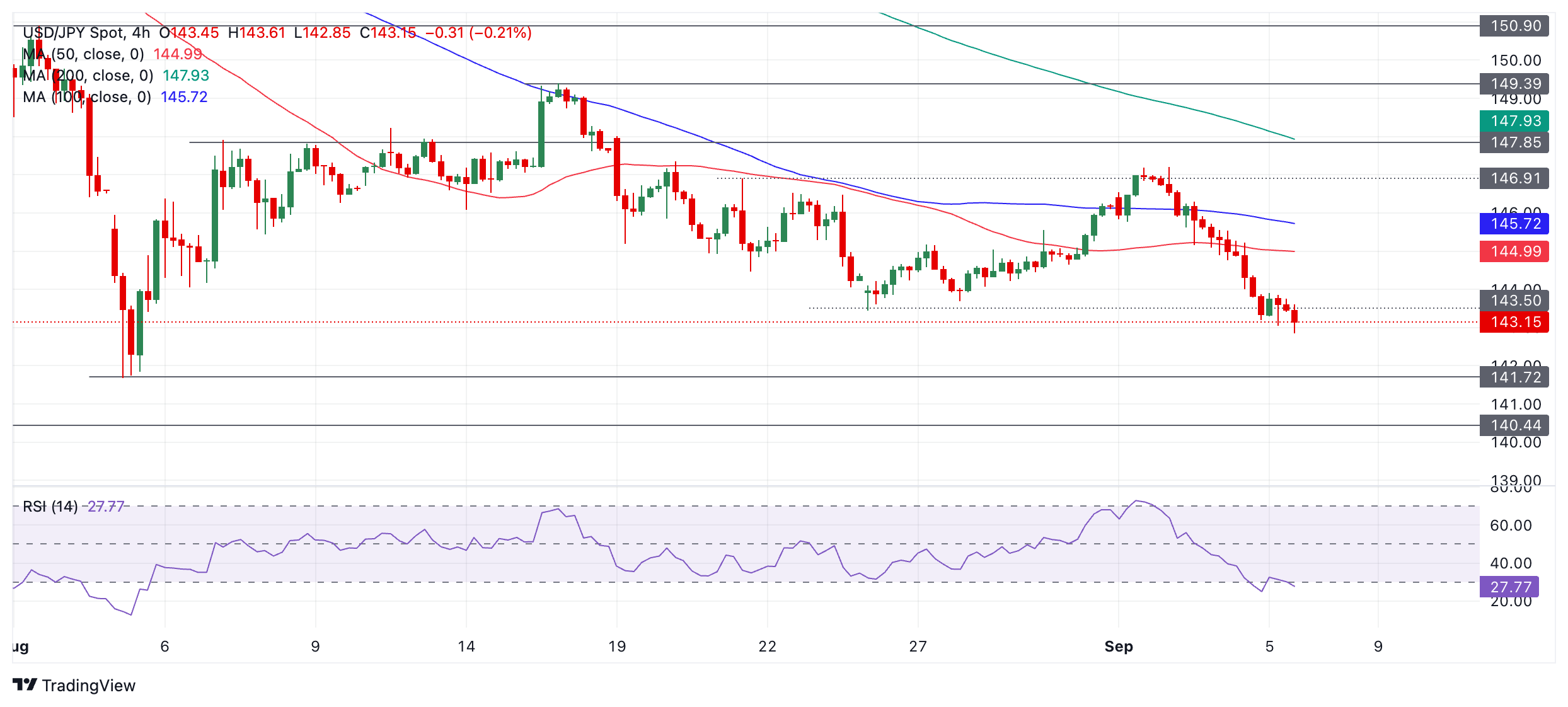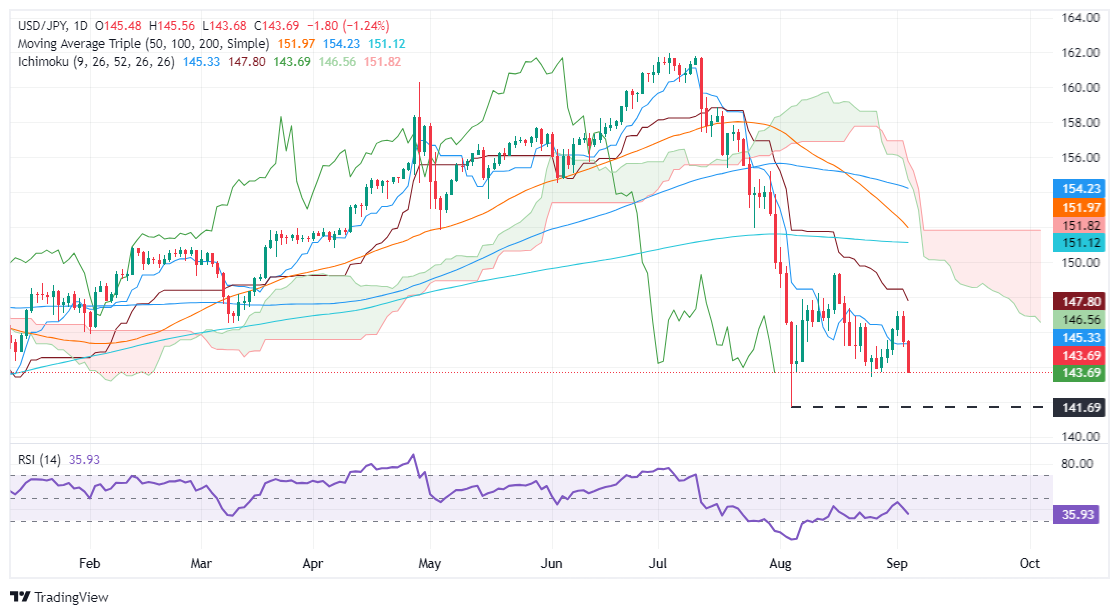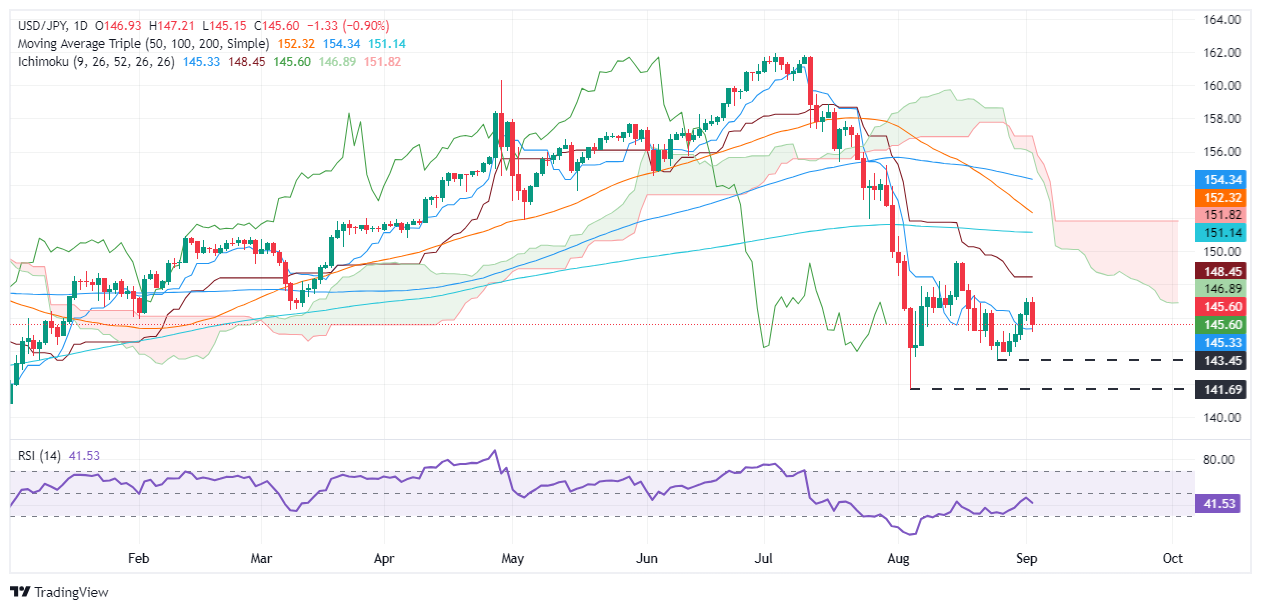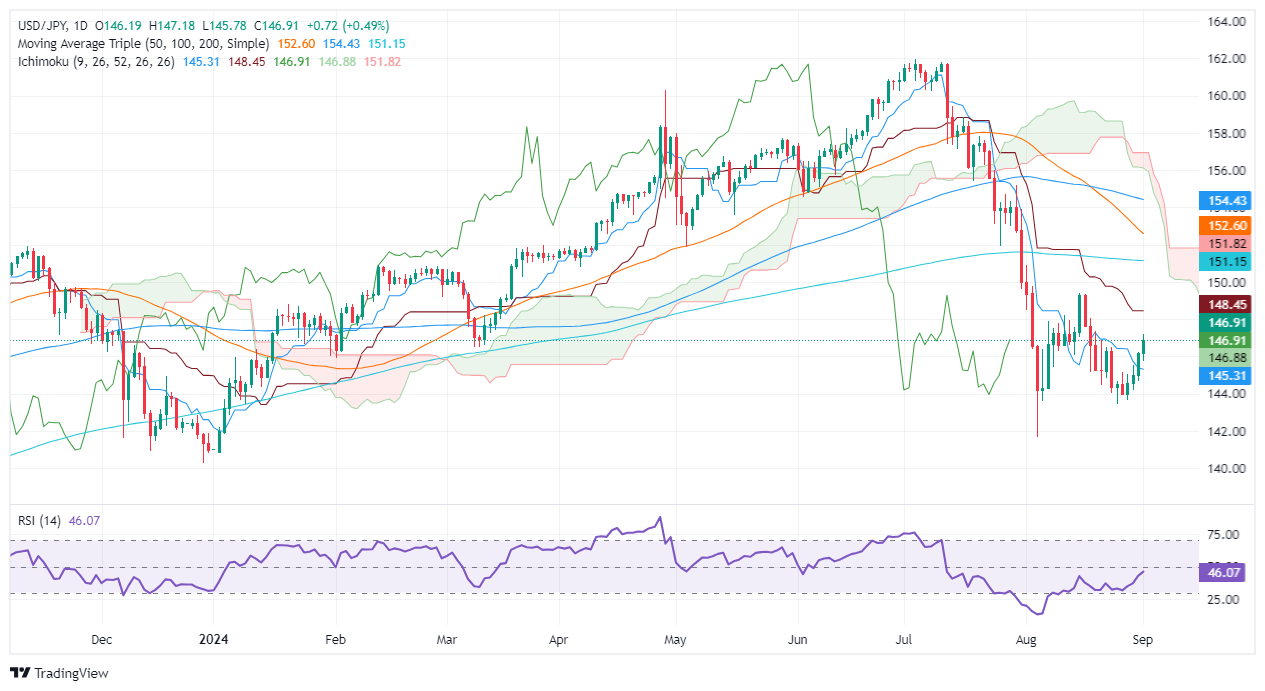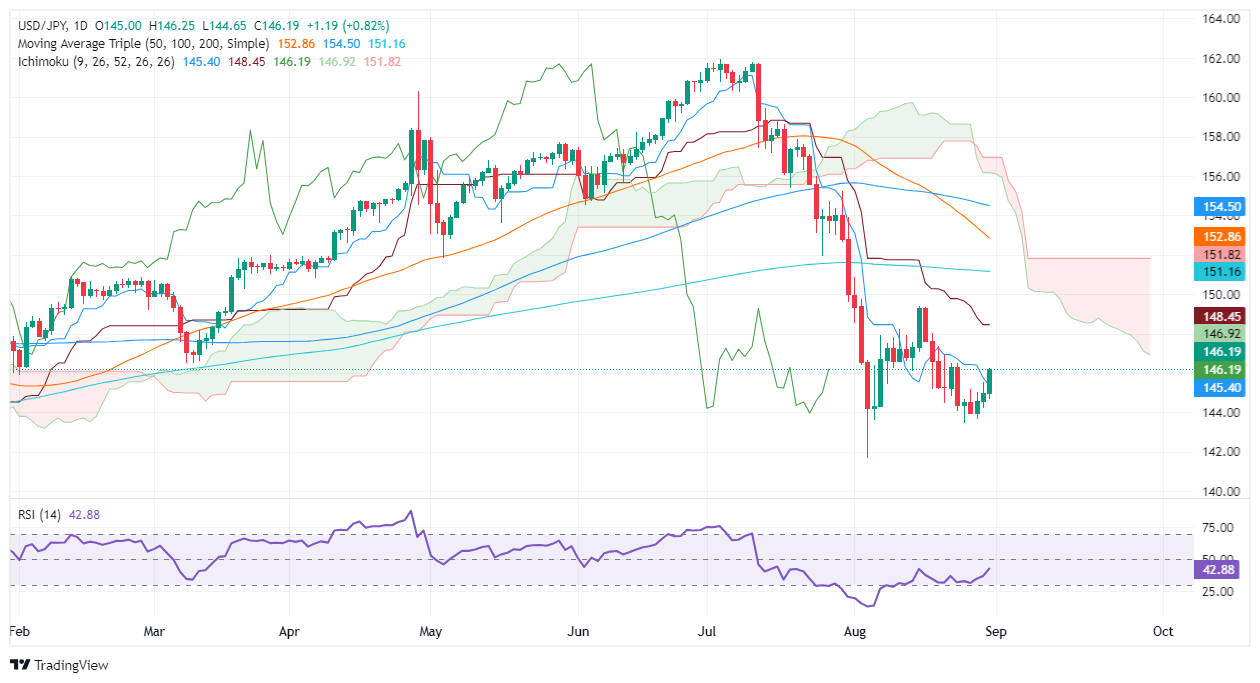- Analytics
- News and Tools
- Quotes
- Chart and quotes for USDJPY
CFD Trading Rate US Dollar vs Japanese Yen (USDJPY)
| Date | Rate | Change |
|---|
Related news
-
10.09.2024 07:55USD/JPY Price Forecast: Sticks to modest gains near mid-143.00s, not out of the woods yet
- USD/JPY gains positive traction for the second straight day, albeit lacks bullish conviction.
- The formation of a descending channel points to a well-established short-term uptrend.
- A move beyond the 144.00 mark is needed to support prospects for further appreciation.
The USD/JPY pair attracts some buyers for the second straight day on Tuesday and trades around mid-143.00s during the first half of the European session. Spot prices, however, lack bullish conviction and remain below the overnight swing high as traders prefer to wait on the sidelines ahead of the crucial US inflation figures this week.
In the meantime, a downward revision of the second quarter Gross Domestic Product (GDP) print continues to undermine the Japanese Yen (JPY) and acts as a tailwind for the USD/JPY pair amid a modest US Dollar (USD) uptick. That said, the divergent Federal Reserve (Fed)-Bank of Japan (BoJ) policy expectations hold back investors from placing aggressive bullish bets and cap the upside for the currency pair.
From a technical perspective, the recent downfall witnessed over the past four weeks or so has been along a descending channel. This points to a well-established short-term downtrend and supports prospects for the emergence of fresh selling at higher levels. The negative outlook is reinforced by the fact that oscillators on the daily chart are holding deep in negative territory and are still away from being in the oversold zone.
Hence, any subsequent move up might still be seen as a selling opportunity and remain capped near the 144.00 mark. That said, some follow-through buying could trigger a short-covering rally and lift the USD/JPY pair to the next relevant hurdle around the 144.55 region. The momentum could extend further towards reclaiming the 145.00 psychological mark before spot prices climb further toward the 145.60 resistance zone.
On the flip side, the 143.20 area is likely to protect the immediate downside ahead of the 143.00 mark and the Asian session low, around the 142.85 region. Failure to defend the said support levels will reaffirm the negative bias and expose the 142.00 round figure and a seven-month low, around the 141.70-141.65 region touched in August.
USD/JPY 4-hour chart
Japanese Yen FAQs
The Japanese Yen (JPY) is one of the world’s most traded currencies. Its value is broadly determined by the performance of the Japanese economy, but more specifically by the Bank of Japan’s policy, the differential between Japanese and US bond yields, or risk sentiment among traders, among other factors.
One of the Bank of Japan’s mandates is currency control, so its moves are key for the Yen. The BoJ has directly intervened in currency markets sometimes, generally to lower the value of the Yen, although it refrains from doing it often due to political concerns of its main trading partners. The current BoJ ultra-loose monetary policy, based on massive stimulus to the economy, has caused the Yen to depreciate against its main currency peers. This process has exacerbated more recently due to an increasing policy divergence between the Bank of Japan and other main central banks, which have opted to increase interest rates sharply to fight decades-high levels of inflation.
The BoJ’s stance of sticking to ultra-loose monetary policy has led to a widening policy divergence with other central banks, particularly with the US Federal Reserve. This supports a widening of the differential between the 10-year US and Japanese bonds, which favors the US Dollar against the Japanese Yen.
The Japanese Yen is often seen as a safe-haven investment. This means that in times of market stress, investors are more likely to put their money in the Japanese currency due to its supposed reliability and stability. Turbulent times are likely to strengthen the Yen’s value against other currencies seen as more risky to invest in.
-
10.09.2024 01:09USD/JPY steadily climbs back closer to mid-143.00s, upside potential seems limited
- USD/JPY ticks higher for the second straight day and draws support from a combination of factors.
- A downward revision of Japan’s GDP print and a positive risk tone undermines the safe-haven JPY.
- Reduced bets for a 50 bps Fed rate cut in September push the USD higher and further lend support.
The USD/JPY pair turns positive for the second straight day following an early Asian session dip to the 142.85 region, albeit it lacks bullish conviction. Spot prices currently trade with a mild positive bias just below mid-143.00s and remain well within the striking distance of a one-month low touched last Friday.
The Japanese Yen (JPY) continues to be undermined by data published on Monday, which showed that the economy grew at a slightly slower pace than initially reported in the second quarter. This could possibly complicate the Bank of Japan's (BoJ) plan to hike interest rates further in the coming months. Apart from this, a generally positive risk tone around the equity markets dents demand for the safe-haven JPY and acts as a tailwind for the USD/JPY pair amid some follow-through US Dollar (USD) buying interest.
The USD Index (DXY), which tracks the Greenback against a basket of currencies, climbs to a multi-day peak amid reduced bets for a larger, 50 basis points (bps) interest rate cut by the Federal Reserve (Fed) in September. The markets, however, have fully priced in at least a 25 bps Fed rate cut move later this month. In contrast, the BoJ is expected to hike interest rates again by the end of this year. This might hold back bullish traders from placing aggressive bets around the USD/JPY pair and cap gains.
Investors might also prefer to move to the sidelines and wait for the release of the US consumer inflation figures on Wednesday before placing fresh directional bets. Hence, a strong follow-through buying is needed in order to confirm that the USD/JPY pair has formed a near-term bottom and positioning for any meaningful appreciating move amid absent relevant US macro data on Tuesday. That said, speeches by influential FOMC members might provide some impetus later during the US session.
Japanese Yen FAQs
The Japanese Yen (JPY) is one of the world’s most traded currencies. Its value is broadly determined by the performance of the Japanese economy, but more specifically by the Bank of Japan’s policy, the differential between Japanese and US bond yields, or risk sentiment among traders, among other factors.
One of the Bank of Japan’s mandates is currency control, so its moves are key for the Yen. The BoJ has directly intervened in currency markets sometimes, generally to lower the value of the Yen, although it refrains from doing it often due to political concerns of its main trading partners. The current BoJ ultra-loose monetary policy, based on massive stimulus to the economy, has caused the Yen to depreciate against its main currency peers. This process has exacerbated more recently due to an increasing policy divergence between the Bank of Japan and other main central banks, which have opted to increase interest rates sharply to fight decades-high levels of inflation.
The BoJ’s stance of sticking to ultra-loose monetary policy has led to a widening policy divergence with other central banks, particularly with the US Federal Reserve. This supports a widening of the differential between the 10-year US and Japanese bonds, which favors the US Dollar against the Japanese Yen.
The Japanese Yen is often seen as a safe-haven investment. This means that in times of market stress, investors are more likely to put their money in the Japanese currency due to its supposed reliability and stability. Turbulent times are likely to strengthen the Yen’s value against other currencies seen as more risky to invest in.
-
09.09.2024 13:58USD/JPY Price Forecast: Testing key lows, long-term uptrend at risk
- USD/JPY has fallen to a key low – if it breaks and closes below it could threaten the uptrend.
- Such a move would probably turn the odds more in favor of bears.
USD/JPY is testing support at key lows from where it bottomed and pulled back during August. If price breaks back below these lows it could risk signaling a reversal of the long-term uptrend, and suggest a major bearish shift in the technical outlook for the pair.
USD/JPY Daily Chart
The pair has already broken below a major multi-year trendline, suggesting the long-term uptrend has been undermined. However, to confirm a reversal, price would have to break and close (on a daily or preferably weekly basis) below the August 5 low at 141.69.
Strong support comes in at 140.25 (December 2023 low) and this could slow the pair’s descent. A break below that level too, would provide even more confirmatory evidence of a reversal in the trend.
Given it is a principle of technical analysis theory that “the trend is your friend” , establishing the direction of the trend helps forecast where price is most likely to go next, so such a breakdown would increase the odds of more downside evolving in the future.
-
09.09.2024 08:14USD/JPY strengthens further beyond 143.00, hits fresh daily peak amid modest USD strength
- USD/JPY stages a goodish recovery from over a one-month low touched on Friday.
- The JPY is undermined by a downward revision of Japan’s Q2 GDP growth figures.
- Reduced bets for a larger Fed rate cut boost the USD and lend additional support.
The USD/JPY pair attracts fresh buyers at the start of a new week and reverses a major part of Friday's losses to the 141.75 area or over a one-month low. Spot prices maintain the bid tone through the early European session and currently trade around the 143.20 mark and draw support from a combination of factors.
The Japanese Yen (JPY) is pressured by a downward revision of the second quarter Gross Domestic Product (GDP) print, which, in turn, is seen as a key factor acting as a tailwind for the USD/JPY pair. Official data published earlier today showed that Japan's economy grew at a slightly slower pace, by an annualized 2.9% in the April-June quarter as compared to a 3.1% rise in the preliminary estimate. This, along with a sluggish consumer spending growth in July, might complicate the Bank of Japan's (BoJ) plans to hike interest rates in the coming months.
Apart from this, a generally positive tone around the European equity markets is seen undermining demand for the safe-haven JPY. The US Dollar (USD), on the other hand, builds on Friday's recovery from over a one-week low amid an uptick in the US Treasury bond yields, bolstered by reduced bets for a 50 basis points (bps) interest rate cut by the Federal Reserve (Fed) later this month. This further contributes to the USD/JPY pair's intraday positive move, though the divergent BoJ-Fed policy expectations warrant some caution before positioning for further gains.
The BoJ Governor Kazuo Ueda said last week that the central bank will continue to raise interest rates if the economy and prices perform as expected. Adding to this, an unexpected rise in Japan's real wages for the second straight month in July keeps hopes alive for another BoJ rate hike by the end of 2024. Hence, it will be prudent to wait for strong follow-through buying beyond the 143.75-143.80 horizontal support breakpoint before confirming that the USD/JPY pair's recent downfall has run its course and positioning for any further appreciating move.
Bank of Japan FAQs
The Bank of Japan (BoJ) is the Japanese central bank, which sets monetary policy in the country. Its mandate is to issue banknotes and carry out currency and monetary control to ensure price stability, which means an inflation target of around 2%.
The Bank of Japan has embarked in an ultra-loose monetary policy since 2013 in order to stimulate the economy and fuel inflation amid a low-inflationary environment. The bank’s policy is based on Quantitative and Qualitative Easing (QQE), or printing notes to buy assets such as government or corporate bonds to provide liquidity. In 2016, the bank doubled down on its strategy and further loosened policy by first introducing negative interest rates and then directly controlling the yield of its 10-year government bonds.
The Bank’s massive stimulus has caused the Yen to depreciate against its main currency peers. This process has exacerbated more recently due to an increasing policy divergence between the Bank of Japan and other main central banks, which have opted to increase interest rates sharply to fight decades-high levels of inflation. The BoJ’s policy of holding down rates has led to a widening differential with other currencies, dragging down the value of the Yen.
A weaker Yen and the spike in global energy prices have led to an increase in Japanese inflation, which has exceeded the BoJ’s 2% target. With wage inflation becoming a cause of concern, the BoJ looks to move away from ultra loose policy, while trying to avoid slowing the activity too much.
-
09.09.2024 02:15USD/JPY rises to near 143.00 following lower-than-expected Japan GDP data
- USD/JPY breaks its four-day losing streak after weaker Gross Domestic Product data from Japan on Monday.
- Friday’s US labor data reduces the likelihood of an aggressive Fed rate cut in September.
- CME FedWatch Tool suggests the odds of a 50 basis points Fed rate cut have slightly decreased to 29.0%.
USD/JPY halts its four-day losing streak, trading around 142.90 during the Asian session on Monday. The USD/JPY pair's recovery can be partly attributed to lower-than-expected Gross Domestic Product (GDP) data from Japan. However, robust economic growth, rising wages, and persistent inflationary pressures continue to support expectations that the Bank of Japan (BoJ) may further raise interest rates, which could limit the downside for the Japanese Yen (JPY).
Japan's GDP Annualized expanded by 2.9% in the second quarter, slightly below the preliminary reading of 3.1% and the market estimate of 3.2%. However, this reading marks the strongest yearly expansion since Q1 2023. On a quarter-on-quarter basis, GDP grew by 0.7% in Q2, falling short of the market forecast of 0.8% but representing the strongest quarterly growth since Q2 2023.
Additionally, the US Dollar received support as Friday’s US economic data raised uncertainty over the likelihood of an aggressive interest rate cut by the Federal Reserve (Fed) at its September meeting. According to the CME FedWatch Tool, markets are fully anticipating at least a 25 basis point (bps) rate cut by the Federal Reserve at its September meeting. The likelihood of a 50 bps rate cut has slightly decreased to 29.0%, down from 30.0% a week ago.
The US Bureau of Labor Statistics (BLS) reported that Nonfarm Payrolls (NFP) added 142,000 jobs in August, below the forecast of 160,000 but an improvement from July’s downwardly revised figure of 89,000. Meanwhile, the Unemployment Rate fell to 4.2%, as expected, down from 4.3% in the previous month.
Japanese Yen FAQs
The Japanese Yen (JPY) is one of the world’s most traded currencies. Its value is broadly determined by the performance of the Japanese economy, but more specifically by the Bank of Japan’s policy, the differential between Japanese and US bond yields, or risk sentiment among traders, among other factors.
One of the Bank of Japan’s mandates is currency control, so its moves are key for the Yen. The BoJ has directly intervened in currency markets sometimes, generally to lower the value of the Yen, although it refrains from doing it often due to political concerns of its main trading partners. The current BoJ ultra-loose monetary policy, based on massive stimulus to the economy, has caused the Yen to depreciate against its main currency peers. This process has exacerbated more recently due to an increasing policy divergence between the Bank of Japan and other main central banks, which have opted to increase interest rates sharply to fight decades-high levels of inflation.
The BoJ’s stance of sticking to ultra-loose monetary policy has led to a widening policy divergence with other central banks, particularly with the US Federal Reserve. This supports a widening of the differential between the 10-year US and Japanese bonds, which favors the US Dollar against the Japanese Yen.
The Japanese Yen is often seen as a safe-haven investment. This means that in times of market stress, investors are more likely to put their money in the Japanese currency due to its supposed reliability and stability. Turbulent times are likely to strengthen the Yen’s value against other currencies seen as more risky to invest in.
-
06.09.2024 20:14USD/JPY Price Forecast: Downtrend resumes boosted by falling US yields
- USD/JPY downtrend continues, as downward momentum accelerates after volatility from US Nonfarm Payrolls data.
- Key support levels include 142.50, 142.00, and today’s low of 141.77, with further downside likely if these are breached.
- Resistance stands at 143.44, with higher targets at 144.49 (Tenkan-Sen) and 145.00 (Senkou Span A) if bulls regain control.
The USD/JPY extended its losses late on Friday's North American session, bolstered by the losses of the yield of the US 10-year T-note. The Greenback recovered some ground against most G8 FX currencies, except safe-haven currencies like the Japanese Yen. At the time of writing, the pair trades at
USD/JPY Price Forecast: Technical outlook
The USD/JPY downtrend continued after the latest US Nonfarm Payrolls report sparked volatility in the pair, which seesawed within a 230-pip range on the day, but as the dust settled, sellers remained in charge.
Momentum had accelerated to the downside, confirmed by the Relative Strength Index (RSI) aiming lower, an indication of a strong trend.
The USD/JPY's first support would be the psychological level of 142.50. Once surpassed, the next stop would be the 142.00 mark, followed by today’s low of 141.77. Once those two levels are cleared, the drop could extend toward the August 5 low of 141.69.
On the other hand, the first resistance would be the August 26 daily low of 143.44. A breach of the latter would expose key resistance levels. First, the Tenkan-Sen will be at 144.49, followed by the Senkou Span A at 145.00. Up next would be the Kijun-Sen at 145.73.
USD/JPY Price Action – Daily Chart
Japanese Yen FAQs
The Japanese Yen (JPY) is one of the world’s most traded currencies. Its value is broadly determined by the performance of the Japanese economy, but more specifically by the Bank of Japan’s policy, the differential between Japanese and US bond yields, or risk sentiment among traders, among other factors.
One of the Bank of Japan’s mandates is currency control, so its moves are key for the Yen. The BoJ has directly intervened in currency markets sometimes, generally to lower the value of the Yen, although it refrains from doing it often due to political concerns of its main trading partners. The current BoJ ultra-loose monetary policy, based on massive stimulus to the economy, has caused the Yen to depreciate against its main currency peers. This process has exacerbated more recently due to an increasing policy divergence between the Bank of Japan and other main central banks, which have opted to increase interest rates sharply to fight decades-high levels of inflation.
The BoJ’s stance of sticking to ultra-loose monetary policy has led to a widening policy divergence with other central banks, particularly with the US Federal Reserve. This supports a widening of the differential between the 10-year US and Japanese bonds, which favors the US Dollar against the Japanese Yen.
The Japanese Yen is often seen as a safe-haven investment. This means that in times of market stress, investors are more likely to put their money in the Japanese currency due to its supposed reliability and stability. Turbulent times are likely to strengthen the Yen’s value against other currencies seen as more risky to invest in.
-
06.09.2024 14:02USD/JPY Price Prediction: Bouncing from close to August 5 lows
- USD/JPY is rebounding from key support near the August 5 lows.
- It is forming a bullish candlestick although it is not possible to be certain until the current 4-hour period ends.
- The trend remains bearish although a correction higher looks likely.
USD/JPY has fallen close to the August 5 lows and bounced. It is forming a large, bullish Hammer Japanese candlestick pattern on the 4-hour chart – if the current period ends with the pattern intact it could signal the start of a substantial pull-back or correction higher.
USD/JPY 4-hour Chart
The Relative Strength Index (RSI) momentum indicator has exited oversold, giving a buy signal and indicating a greater chance of a counter-trend correction evolving. The RSI has also itself formed a double bottom pattern when looking at the previous time it was oversold on September 4. This is further evidence strengthening the case for a bullish reaction.
The short-term trend remains down, however, and it is too early to be sure that the pair is reversing the trend fully. The correction higher could soon run out of steam, leading the pair to recapitulate and start falling in line with the trend. It is a major tenet of technical analysis that “the trend is your friend” and the odds favor a continuation lower.
However, it would require a break below the August 5 lows at 141.69 to confirm a continuation lower. Such a move would probably then fall to support at 140.44 initially, the December 2023 lows.
-
06.09.2024 13:11USD/JPY holds losses after weak NFPs from the US
- US Dollar's weakness continues after August Nonfarm Payrolls came in lower than expected, reflecting broader labor market concerns.
- Market expectations for a Federal Reserve interest rate cut have risen, driven by signs of a slowing US labor market and softer job growth.
- The odds of a 50 bps cut in September by the Fed rose to nearly 50%.
The USD/JPY tallies 0.30% losses on Friday as the USD extends its broad weakness after soft Nonfarm Payrolls figures from the US.
The US Dollar's appeal has weakened following a weaker-than-expected August Nonfarm Payrolls (NFP) report, which showed 142K new jobs, below estimates of 160K but above July’s revised 89K. The Unemployment Rate fell as expected to 4.2% from 4.3%. Other data showed that Average Hourly Earnings rose by 3.8% year-on-year, exceeding expectations.
This decline in labor market conditions, alongside disappointing JOLTS Job Openings and ADP Employment data, has fueled concerns about a slowing economy along the week and markets are getting confident about a bigger cut in September by the Federal Reserve (Fed).
USD/JPY technical outlook
The USD/JPY outlook is negative as the Relative Strength Index (RSI) hovers near the oversold level of 30, signaling potential downward momentum which could eventually lead to a correction though. Additionally, the Moving Average Convergence Divergence (MACD) is printing higher red bars, reinforcing the bearish sentiment in the pair.
As stated, the pair saw four sessions of losses and could see an upward correction anytime soon.
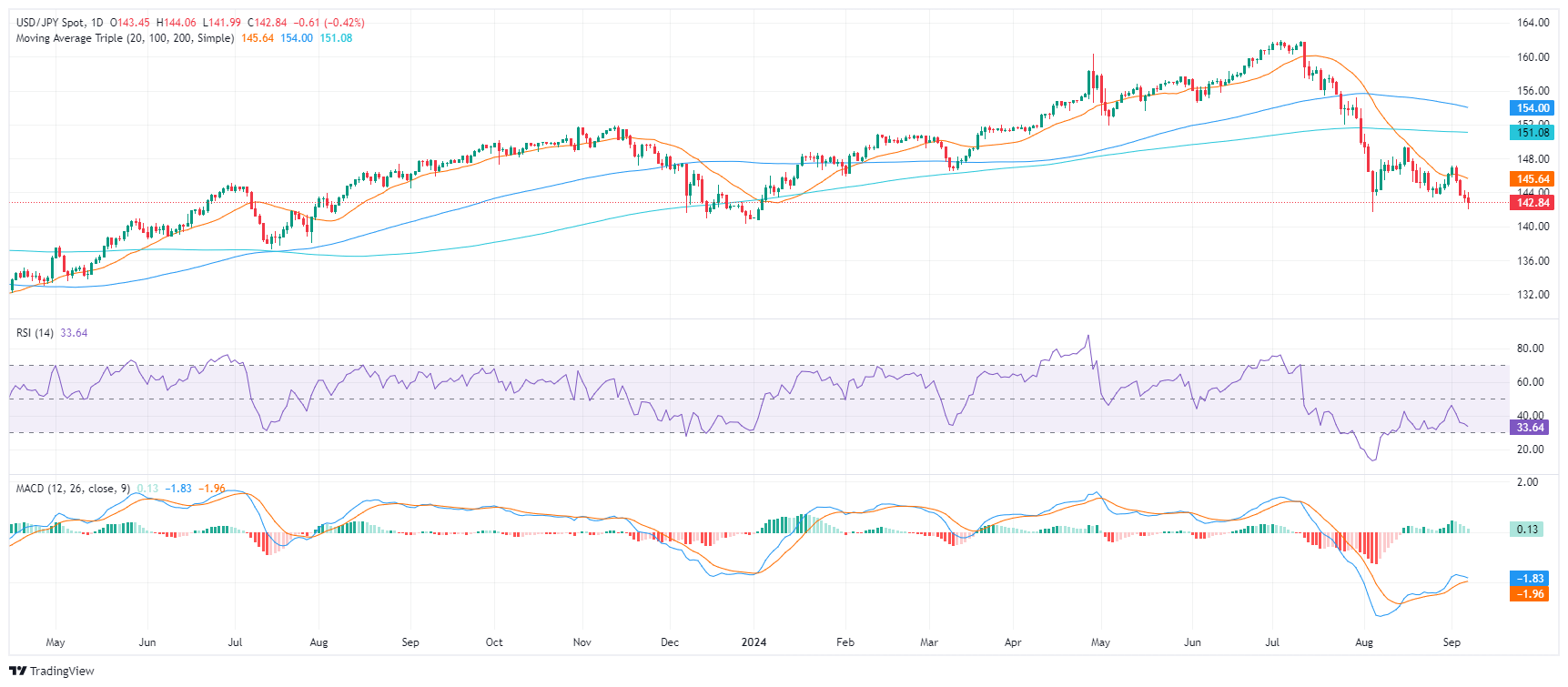
-
06.09.2024 10:46USD/JPY: A death cross is upon us – OCBC
USD/JPY extended its move lower, tracking decline in broad USD, OCBC Frances Cheung and Christopher Wong note.
The broader direction of travel for USD/JPY is to the downside
“Pair was last seen at 142.86. Bullish momentum on daily chart faded while RSI fell. Death cross formed with 50DMA cutting 200DMA to the downside. Risks skewed to the downside. Support at 142, 141.70 (Aug low). Resistance at 145.70 (21 DMA), 146.40 (23.6% fibo retracement of Jul high to Aug low) and147.20 (recent high).”
“Earlier in the week, BoJ Governor submitted a document to government panel, which reiterated that the BoJ would continue to raise interest rates if the economy and prices perform as expected by the BoJ.”
“Fed-BoJ policy shifts and growing pace of normalisation can bring about faster narrowing of UST-JGB yield differentials and this should continue to underpin the broader direction of travel for USD/JPY to the downside.”
-
06.09.2024 09:05USD/JPY finds support near 142.00, recovers few pips from over one-month low ahead of NFP
- USD/JPY continues losing ground for the fourth straight day and drops to over a one-month low.
- The divergent Fed-BoJ policy expectations turn out to be a key factor exerting downward pressure.
- Bears take a brief pause and now look to the US NFP report before positioning for further losses.
The USD/JPY pair remains under some selling pressure for the fourth straight day and drops to over a one-month low, around the 142.00 round-figure mark on Friday. Spot prices, however, trim a part of intraday losses and climb back above mid-142.00s during the first half of the European session amid some repositioning trade ahead of the crucial US monthly employment details.
The popularly known Nonfarm Payrolls (NFP) report will play a key role in influencing expectations about the Federal Reserve's (Fed) policy path and drive the US Dollar (USD) demand. Any meaningful recovery for the USD/JPY pair, however, seems elusive in the wake of divergent Fed-Bank of Japan (BoJ) policy outlook. In fact, the markets are pricing in a 40% chance that the US central bank will lower borrowing costs by 50 basis points (bps) at the end of the September 17-18 policy meeting.
The bets were reaffirmed by rather an unimpressive US macro data released this week, which pointed to a cooling labor market and suggested that the economy is at risk of a slowdown. In contrast, BoJ Governor Kazuo Ueda reiterated earlier this week that the central bank will continue to raise interest rates if the economy and prices perform as expected. Furthermore, an unexpected rise in Japan's real wages for the second straight month in July keeps the BoJ on track for another rate hike in 2024.
Apart from this, renewed worries about a US economic downturn, along with persistent geopolitical tensions, might continue to underpin the safe-haven JPY and contribute to capping the upside for the USD/JPY pair. Hence, any meaningful recovery attempt might still be seen as a selling opportunity and run the risk of fizzling out rather quickly. Nevertheless, spot prices remain on track to register heavy weekly losses and seem vulnerable to prolonging a nearly two-month-old downtrend.
Economic Indicator
Nonfarm Payrolls
The Nonfarm Payrolls release presents the number of new jobs created in the US during the previous month in all non-agricultural businesses; it is released by the US Bureau of Labor Statistics (BLS). The monthly changes in payrolls can be extremely volatile. The number is also subject to strong reviews, which can also trigger volatility in the Forex board. Generally speaking, a high reading is seen as bullish for the US Dollar (USD), while a low reading is seen as bearish, although previous months' reviews and the Unemployment Rate are as relevant as the headline figure. The market's reaction, therefore, depends on how the market assesses all the data contained in the BLS report as a whole.
Read more.Next release: Fri Sep 06, 2024 12:30
Frequency: Monthly
Consensus: 160K
Previous: 114K
Source: US Bureau of Labor Statistics
America’s monthly jobs report is considered the most important economic indicator for forex traders. Released on the first Friday following the reported month, the change in the number of positions is closely correlated with the overall performance of the economy and is monitored by policymakers. Full employment is one of the Federal Reserve’s mandates and it considers developments in the labor market when setting its policies, thus impacting currencies. Despite several leading indicators shaping estimates, Nonfarm Payrolls tend to surprise markets and trigger substantial volatility. Actual figures beating the consensus tend to be USD bullish.
-
05.09.2024 22:18USD/JPY Price Forecast: Downtrend resumes, yet buyers recover 143.00
- USD/JPY remains pressured near 143.39, with momentum indicators favoring a bearish continuation toward 143.00 and 142.50 support levels.
- Failure to decisively clear 143.44 may offer a recovery opportunity for USD bulls if US Nonfarm Payrolls data impresses.
- Key resistance sits at 145.03 (Tenkan-Sen), with further hurdles at 145.73 (Kijun-Sen) and the 150.00 figure.
USD/JPY extended its losses for the third consecutive day, hitting a four-week low of 142.85, yet traders lifted the pair, which closed Thursday's session with losses of 0.21%. As Friday’s Asian session begins, the pair trades at 143.39, virtually unchanged.
USD/JPY Price Forecast: Technical outlook
The USD/JPY fell toward multi-week lows but failed to decisively clear the August 26 swing low of 143.44. This can pave the way for a recovery for USD bulls, who struggled with the drop in the US 10-year T-note yield.
Despite this, momentum favors further downside, as shown by the Relative Strength Index (RSI). With this and first-tier US August’s Nonfarm Payrolls report looming, the path of least resistance is for a bearish continuation.
The USD/JPY's first support would be the August 26 daily low of 143.44. A breach of the latter would expose key psychological support levels, like the 143.00 mark. This would be followed by the current week's low of 142.85, ahead of key psychological levels, the 142.50 mark and 142.00.
Conversely, an upbeat US jobs report will expose key resistance levels. First, the Tenkan-Sen will be at 145.03, followed by the Kijun-Sen at 145.73, before reclaiming the 150.00 figure above the latest cycle high of 149.39.
USD/JPY Price Action – Daily Chart
Japanese Yen PRICE Today
The table below shows the percentage change of Japanese Yen (JPY) against listed major currencies today. Japanese Yen was the strongest against the Swiss Franc.
USD EUR GBP JPY CAD AUD NZD CHF USD -0.00% 0.02% -0.04% -0.00% -0.01% 0.00% 0.03% EUR 0.00% 0.02% -0.06% -0.02% 0.02% -0.01% 0.02% GBP -0.02% -0.02% -0.06% -0.02% -0.02% -0.01% 0.00% JPY 0.04% 0.06% 0.06% 0.05% 0.05% 0.03% 0.07% CAD 0.00% 0.02% 0.02% -0.05% -0.01% 0.00% 0.02% AUD 0.00% -0.02% 0.02% -0.05% 0.00% -0.01% 0.01% NZD -0.00% 0.00% 0.01% -0.03% -0.01% 0.00% 0.01% CHF -0.03% -0.02% -0.01% -0.07% -0.02% -0.01% -0.01% The heat map shows percentage changes of major currencies against each other. The base currency is picked from the left column, while the quote currency is picked from the top row. For example, if you pick the Japanese Yen from the left column and move along the horizontal line to the US Dollar, the percentage change displayed in the box will represent JPY (base)/USD (quote).
-
05.09.2024 13:16USD/JPY Price Prediction: Downtrend resumes, bears target August lows
- USD/JPY has broken below a key support level and is falling lower.
- The August 5 lows are the next target at 141.69.
USD/JPY is resuming its mid-term downtrend after a punctuated pause during August.
The pair has broken below the key 143.45 swing lows (August 26 low) – a bearish sign that flips the trend. Sellers now have the key August 5 lows at 141.69 in their sights.
USD/JPY 4-hour Chart
USD/JPY is probably in a short-term downtrend and given the saying “the trend is your friend” the odds favor more downside.
The pair will probably reach the 141.69 lows. A break below that would probably lead to further weakness towards the next support level at 140.44.
The Relative Strength Index (RSI) momentum indicator is oversold, however, so traders are advised not to add to their short positions. If RSI exits oversold it will be a signal a counter-trend correction higher is unfolding.
-
05.09.2024 09:30USD/JPY: Sideways near the lows – OCBC
USD/JPY continued to trade lower, following the broad decline in USD, UST yields, OCBC FX strategists Frances Cheung and Christopher Wong note.
USD/JPY continues to trade lower
“Earlier in the week, BoJ Governor submitted a document to government panel, which reiterated that the BoJ would continue to raise interest rates if the economy and prices perform as expected by the BoJ. Fed-BoJ policy shifts will bring about a narrowing of UST-JGB yield differentials and this should continue to underpin the broader direction of travel for USD/JPY to the downside.”
“Pair was last seen at 143.53. Bullish momentum on daily chart is fading while RSI fell. Sideways trading likely. Support at 143.45 (recent low), 142 levels. Resistance at 145.90 (21 DMA), 147.20 (recent high).”
-
04.09.2024 21:02USD/JPY Price Forecast: Plunges below 144.00 as downtrend resumes
- USD/JPY declines to 143.77, weighed by falling US 10-year Treasury yields and bearish market sentiment.
- Key support at 143.45 is now in focus, with further downside risks toward the 143.00 and 142.50 levels.
- Bulls need to reclaim the Kijun-Sen at 148.45 to regain control, with 150.00 acting as a critical resistance.
The USD/JPY collapsed late during the North American session and fell below 144.00 for the first time since last Wednesday. At the time of writing, the major is at 143.77, losing more than 1%.
Softer than expected, US JOLTS data for July increased speculations that the Federal Reserve will lower rates at the upcoming meeting, being the only doubt about the size of the cut. Consequently, that weighed on the closely correlated US 10-year Treasury note yield with the USD/JPY, with the former extending losses by almost 2% at 3.757%.
USD/JPY Price Forecast: Technical outlook
The USD/JPY resumed its downtrend after registering a leg-up from 143.44 (August 26) to 147.21 (September 3 high), sinking following the US data release, as momentum turned bearish.
The Relative Strength Index (RSI) remained bearish, but its slope shifted upwards to downwards, a sign of a trend shift in the short term.
The USD/JPY first support would be the August 26 daily low of 143.45. A breach of the latter would expose key psychological support levels, like the 143.00 mark, followed by the 142.50 and 142.00. Once hurdled, the next stop would be the August 5 low of 141.69.
For bulls to regain control, they must regain the Kijun-Sen at 148.45 before reclaiming the 150.00 figure above the latest cycle high of 149.39.
USD/JPY Price Action – Daily Chart
Japanese Yen PRICE Today
The table below shows the percentage change of Japanese Yen (JPY) against listed major currencies today. Japanese Yen was the strongest against the Swiss Franc.
USD EUR GBP JPY CAD AUD NZD CHF USD 0.00% 0.00% -0.03% 0.00% 0.06% -0.06% 0.14% EUR -0.01% 0.03% -0.02% 0.00% 0.04% -0.02% 0.15% GBP -0.00% -0.03% -0.04% 0.03% 0.04% -0.04% 0.02% JPY 0.03% 0.02% 0.04% 0.02% 0.07% 0.02% 0.09% CAD 0.00% -0.01% -0.03% -0.02% 0.06% -0.03% 0.02% AUD -0.06% -0.04% -0.04% -0.07% -0.06% -0.03% -0.03% NZD 0.06% 0.02% 0.04% -0.02% 0.03% 0.03% 0.06% CHF -0.14% -0.15% -0.02% -0.09% -0.02% 0.03% -0.06% The heat map shows percentage changes of major currencies against each other. The base currency is picked from the left column, while the quote currency is picked from the top row. For example, if you pick the Japanese Yen from the left column and move along the horizontal line to the US Dollar, the percentage change displayed in the box will represent JPY (base)/USD (quote).
-
04.09.2024 09:41USD/JPY: Trading sideways for now – OCBC
USD/JPY turned lower after BoJ Governor submitted a document to government panel, which reiterated that the BoJ would continue to raise interest rates if the economy and prices perform as expected by the BoJ, OCBC FX strategists Frances Cheung and Christopher Wong note.
Sideways trading is likely
“Fed-BoJ policy shifts will bring about a narrowing of UST-JGB yield differentials and this should continue to underpin the broader direction of travel for USDJPY to the downside Elsewhere, the sell-off in equities (pullback in risk appetite) was also another factor weighing on USDJPY.”
“Pair was last seen at 145.20. Bullish momentum on daily chart intact while decline in RSI moderated. Sideways trading likely. Resistance at 146.10 (21 DMA), 147.20 (recent high). Support at 144.40, 143.45 (recent low).”
-
03.09.2024 20:32USD/JPY Price Forecast: Tumbles on hawkish BoJ tone, firm below 146.00
- USD/JPY forms a bearish engulfing pattern, signaling potential further downside in the near term.
- RSI momentum supports sellers, with first support eyed at Tenkan-Sen 145.33 and psychological 145.00 level.
- Bulls must reclaim Kijun-Sen at 148.45, with 150.00 needed to reverse the bearish trend.
The USD/JPY dropped late in the North American session, registering losses of over 0.80% or more than 100 pips. It now trades at 145.68.
During the overnight session for US traders, headlines revealed that Bank of Japan (BoJ) Governor Kazuo Ueda reiterated his hawkish stance on remarks submitted to a government panel. This was the main driver of the pair, along with the plunge of the yield of the US 10-year Treasury note.
USD/JPY Price Forecast: Technical outlook
From a technical standpoint, the USD/JPY is downward biased, forming a ‘bearish engulfing’ chart pattern. This hints that more downside is seen, further confirmed by the Relative Strength Index (RSI), reassuring that momentum supports sellers.
With the path of least resistance tilted to the downside, USD/JPY's first support would be the Tenkan-Sen at 145.33. If hurdled, the next stop would be the 145.00 figure, ahead of testing the next cycle low of 143.45, the August 26 daily low. This would be the last line of defense for bulls, ahead of the August 5 low of 141.69.
For bulls to regain control, they must regain the Kijun-Sen at 148.45 before reclaiming the 150.00 figure above the latest cycle high of 149.39.
USD/JPY Price Action – Daily Chart
Japanese Yen PRICE Today
The table below shows the percentage change of Japanese Yen (JPY) against listed major currencies today. Japanese Yen was the strongest against the Australian Dollar.
USD EUR GBP JPY CAD AUD NZD CHF USD 0.26% 0.28% -0.92% 0.42% 1.19% 0.93% -0.12% EUR -0.26% 0.00% -1.16% 0.14% 0.91% 0.55% -0.39% GBP -0.28% -0.01% -1.18% 0.14% 0.90% 0.55% -0.39% JPY 0.92% 1.16% 1.18% 1.32% 2.10% 1.67% 0.77% CAD -0.42% -0.14% -0.14% -1.32% 0.75% 0.32% -0.53% AUD -1.19% -0.91% -0.90% -2.10% -0.75% -0.46% -1.29% NZD -0.93% -0.55% -0.55% -1.67% -0.32% 0.46% -0.83% CHF 0.12% 0.39% 0.39% -0.77% 0.53% 1.29% 0.83% The heat map shows percentage changes of major currencies against each other. The base currency is picked from the left column, while the quote currency is picked from the top row. For example, if you pick the Japanese Yen from the left column and move along the horizontal line to the US Dollar, the percentage change displayed in the box will represent JPY (base)/USD (quote).
-
03.09.2024 13:18USD/JPY declines to near 146.00 on BoJ Ueda’s hawkish commentary on interest rates
- USD/JPY drops sharply to near 146.00 as BoJ Ueda delivers hawkish interest rate guidance.
- BoJ Ueda reiterated the need to raise interest rates further this year.
- The Fed is now more focused on controlling downside risks to the US labor market.
The USD/JPY pair falls sharply to near 146.00 in Tuesday’s North American session. The asset faces selling pressure as the Japanese Yen (JPY) strengthens after Bank of Japan (BoJ) Governor Kazuo Ueda’s hawkish commentary on interest rates.
Kazuo Ueda reiterated in a document submitted to a government panel on Tuesday that the central bank won’t hesitate to raise interest rates further if the economy and inflation perform as expected, Reuters reported. Inflationary pressures in the Japanese economy continue to remain stubborn. Tokyo Consumer Price Index (CPI), excluding Fresh Food, released on Thursday, rose at a faster pace to 2.4% in August from estimates and July’s release of 2.2%.
USD/JPY remains on the backfoot despite further upside in the US Dollar (USD). The US Dollar Index (DXY), which tracks the Greenback’s value against six major currencies, rises towards a two-week high of 102.00.
The US Dollar gains as investors turn cautious ahead of the United States (US) Nonfarm Payrolls (NFP) data for August, which will be published on Friday. Market participants will keenly focus on the official labor market data as the Federal Reserve (Fed) is now more focused on preventing labor demand, given that officials are confident about price pressures returning sustainably to the bank’s target of 2%.
In today’s session, investors will focus on the US ISM Manufacturing PMI data for August, which will be published at 14:00 GMT. Economists expect that activities in the manufacturing sector contracted at a slower pace, with the PMI coming in at 47.5 from July’s reading of 46.8.
Japanese Yen FAQs
The Japanese Yen (JPY) is one of the world’s most traded currencies. Its value is broadly determined by the performance of the Japanese economy, but more specifically by the Bank of Japan’s policy, the differential between Japanese and US bond yields, or risk sentiment among traders, among other factors.
One of the Bank of Japan’s mandates is currency control, so its moves are key for the Yen. The BoJ has directly intervened in currency markets sometimes, generally to lower the value of the Yen, although it refrains from doing it often due to political concerns of its main trading partners. The current BoJ ultra-loose monetary policy, based on massive stimulus to the economy, has caused the Yen to depreciate against its main currency peers. This process has exacerbated more recently due to an increasing policy divergence between the Bank of Japan and other main central banks, which have opted to increase interest rates sharply to fight decades-high levels of inflation.
The BoJ’s stance of sticking to ultra-loose monetary policy has led to a widening policy divergence with other central banks, particularly with the US Federal Reserve. This supports a widening of the differential between the 10-year US and Japanese bonds, which favors the US Dollar against the Japanese Yen.
The Japanese Yen is often seen as a safe-haven investment. This means that in times of market stress, investors are more likely to put their money in the Japanese currency due to its supposed reliability and stability. Turbulent times are likely to strengthen the Yen’s value against other currencies seen as more risky to invest in.
-
02.09.2024 21:42USD/JPY Price Forecast: Surges to two-week peak, shy of 147.00
- USD/JPY closed August above Kijun-Sen and Ichimoku Cloud, showing buyer strength; break above 152.00 needed to target YTD high of 161.95.
- Pair consolidates within 140.78-147.30 range inside Ichimoku Cloud, indicating potential for sideways trading. Break above 149.39 required for uptrend continuation; a dip to 141.69 could test Kumo bottom at 140.78.
- Buyer momentum picking up, targeting Kijun-Sen at 148.46. Watch resistance at 147.00 and 148.00; a fall below Senkou Span A at 146.90 may lead to levels at 146.00 and Tenkan-Sen at 145.31, nearing the 145.00 support.
The USD/JPY rises for the fourth straight day on Monday as September commences, up by 0.49% amid thin liquidity conditions during the North American session. At the time of writing, the pair trades at 146.87 after bouncing off a daily low of 145.78.
USD/JPY Price Forecast: Technical outlook
The USD/JPY monthly chart shows the pair dipping toward 141.69 but recovering late and closing at 146.17, above the Kijun-Sen and the Ichimoku Cloud (Kumo). Even though this hints that buyers are in charge, the pair should clear 152.00 to re-test the year-to-date (YTD) high at 161.95.
From a weekly standpoint, the USD/JPY consolidates at around the top of the 140.78-147.30 range inside the Kumo, an indication of sideways trading. For buyers to resume the uptrend, they need to push prices above the latest cycle high of 149.39. On the other hand, sellers need to clear 141.69 before testing the Kumo's bottom at 140.78.
Meanwhile, the USD/JPY daily chart shows that buyers are regaining control. They could push prices toward the Kijun-Sen at 148.46, but first, they need to clear key resistance levels. The first would be the 147.00 figure, followed by the 148.00 threshold.
Conversely, if sellers move in and drag the price below the Senkou Span A at 146.90, that can pave the way for further downside. The next support would be the 146.00 mark, followed by the Tenkan-Sen at 145.31, before challenging 145.00.
USD/JPY Price Action – Daily Chart
Japanese Yen PRICE Today
The table below shows the percentage change of Japanese Yen (JPY) against listed major currencies today. Japanese Yen was the strongest against the US Dollar.
USD EUR GBP JPY CAD AUD NZD CHF USD 0.00% 0.00% -0.03% -0.02% -0.02% 0.18% 0.00% EUR 0.00% -0.01% -0.02% -0.03% -0.03% 0.08% 0.00% GBP -0.01% 0.00% 0.00% -0.02% -0.02% 0.09% 0.00% JPY 0.03% 0.02% 0.00% -0.01% -0.00% 0.00% 0.00% CAD 0.02% 0.03% 0.02% 0.01% -0.02% 0.01% 0.03% AUD 0.02% 0.03% 0.02% 0.00% 0.02% -0.01% 0.03% NZD -0.18% -0.08% -0.09% -0.01% -0.01% 0.00% 0.03% CHF -0.00% 0.00% -0.01% -0.01% -0.03% -0.03% -0.03% The heat map shows percentage changes of major currencies against each other. The base currency is picked from the left column, while the quote currency is picked from the top row. For example, if you pick the Japanese Yen from the left column and move along the horizontal line to the US Dollar, the percentage change displayed in the box will represent JPY (base)/USD (quote).
-
02.09.2024 12:58USD/JPY trades higher as investors continue to bet on the US economy
- USD/JPY is rising on the back of a strengthening US Dollar as traders grow more optimistic about the US economic outlook.
- US employment data out this week will be key in their evaluations and will probably impact the pair.
- The Japanese Yen remains supported by a run of positive data and expectations the BoJ will soon raise interest rates.
USD/JPY is trading up a half a percent in the 146.90s on Monday as the US Dollar (USD) continues its recovery from the late August lows, whilst the Japanese Yen (JPY) treads water.
The US Dollar’s bounce gained some impetus after the release of July’s US Personal Consumption Expenditures (PCE) Price Index on Friday. The PCE is the Federal Reserve’s (Fed) preferred inflation gauge. The data showed that US inflation remained unchanged compared to the previous month and helped reassure investors that the US economy was probably not deccelerating as quickly as some had feared. In a “soft-landing” scenario the US Dollar is likely to hold its strength better than if the economy crashes.
USD/JPY may see its gains capped, however, as the JPY finds support from a run of strong data out of Japan. Capital expenditure by Japanese companies expanded by 7.4% in the second quarter, marking the thirteenth consecutive quarter of growth, data showed on Sunday. Jibun Manufacturing PMI, meanwhile, was revised up to 49.8 from 49.5 in August, moving closer to 50 above which it would mark expansion.
Data out last week further increased the chances of the Bank of Japan (BoJ) raising interest rates in the coming months, a move that would support the Japanese Yen by increasing foreign capital inflows. Annual flash Tokyo CPI ex fresh food for July came out at 2.4% compared to 2.2% in the previous month and beating expectations of 2.2%, according to data from the Statistics Bureau of Japan on Thursday. The Tokyo data suggested that Japan-wide inflation could show a similar rise.
Japan employment data, however, was not as strong. The Japanese Unemployment Rate unexpectedly rose to 2.7% in July from 2.5% in June.
Analysts at Capital Economics, however, dismissed the rise in unemployment saying “our conviction that the Bank (BoJ) will press ahead with another rate hike is growing.”
“The jump in the unemployment rate in July is a lagged response to the weakness in economic activity around the turn of the year,” said Marcel Thieliant, Head of Asia-Pacific at Capital Economics.
US employment data key for USD/JPY
Unlike the Yen, employment data could be key for the Dollar, however, after the Fed Chairman Jerome Powell highlighted risks to the labor market in his pivotal speech in Jackson Hole. Popwell stated that the risks to the labor market now outweighed risks from high inflation.
The week ahead sees a batch of US employment metrics released that will provide more detail on how bad the US employment situation is. These include ADP Employment Change, Initial and Continuing Jobless Claims and the main event – the US Bureau of Labor Statistics Nonfarm Payrolls (NFP) report for August, released on Friday.
If US employment data paints a negative picture of the labor market in the US it could prompt a sell-off in USD/JPY as the Dollar depreciates from traders pricing in steeper interest rate cuts from the Fed.
Currently the probabilities of the Fed making a large 0.50% cut at their September 18 meeting are still only about 30% with a 0.25% cut fully priced in, however, weak employment data could increase the chances of a larger cut with negative effects on USD pairs.
-
30.08.2024 20:59USD/JPY Price Forecast: Soars past 146.00 boosted by US yields
- USD/JPY maintains a downward bias, needing to break key resistances for a bullish shift.
- Short-term buyer momentum faces obstacles at 146.93 (Senkou Span A) and 148.46 (Kijun-Sen), with an eye on the 149.39 peak.
- Mixed RSI signals suggest short-term buyer dominance but an unclear broader trend.
- A drop below 145.39 (Tenkan-Sen) could trigger further losses, with supports at 143.44 (August 26 low) and 141.69 (August 5 low).
The USD/JPY rallied past the 146.00 figure for the first time of the week, as US Treasury bond yields rose sharply following the release of the Fed’s favorite inflation report. The US 10-year Treasury note yield rose four and a half basis points to 3.909%, underpinning the major towards 146.17 after bouncing off daily lows of 145.56.
USD/JPY Price Forecast: Technical outlook
The USD/JPY is downward biased despite surpassing above the Tenkan-Sen lying at 145.39. The Relative Strength Index (RSI) shows that momentum is mixed, with the indicator being at bearish territory but aiming up.
Short-term buyers are in charge, but they must push the USD/JPY spot price above the Senkou Span A at 146.93 and clear the Kijun-Sen at 148.46 before they can clear the latest cycle high at 149.39, the August 15 daily high.
Conversely, a USD/JPY move below the Tenkan-Sen will expose the latest cycle low, seen at 143.44, the August 26 low. The pair could extend its losses past that level, and sellers could target August 5 through 141.69.
USD/JPY Price Action – Daily Chart
Japanese Yen FAQs
The Japanese Yen (JPY) is one of the world’s most traded currencies. Its value is broadly determined by the performance of the Japanese economy, but more specifically by the Bank of Japan’s policy, the differential between Japanese and US bond yields, or risk sentiment among traders, among other factors.
One of the Bank of Japan’s mandates is currency control, so its moves are key for the Yen. The BoJ has directly intervened in currency markets sometimes, generally to lower the value of the Yen, although it refrains from doing it often due to political concerns of its main trading partners. The current BoJ ultra-loose monetary policy, based on massive stimulus to the economy, has caused the Yen to depreciate against its main currency peers. This process has exacerbated more recently due to an increasing policy divergence between the Bank of Japan and other main central banks, which have opted to increase interest rates sharply to fight decades-high levels of inflation.
The BoJ’s stance of sticking to ultra-loose monetary policy has led to a widening policy divergence with other central banks, particularly with the US Federal Reserve. This supports a widening of the differential between the 10-year US and Japanese bonds, which favors the US Dollar against the Japanese Yen.
The Japanese Yen is often seen as a safe-haven investment. This means that in times of market stress, investors are more likely to put their money in the Japanese currency due to its supposed reliability and stability. Turbulent times are likely to strengthen the Yen’s value against other currencies seen as more risky to invest in.
© 2000-2024. All rights reserved.
This site is managed by Teletrade D.J. LLC 2351 LLC 2022 (Euro House, Richmond Hill Road, Kingstown, VC0100, St. Vincent and the Grenadines).
The information on this website is for informational purposes only and does not constitute any investment advice.
The company does not serve or provide services to customers who are residents of the US, Canada, Iran, The Democratic People's Republic of Korea, Yemen and FATF blacklisted countries.
Making transactions on financial markets with marginal financial instruments opens up wide possibilities and allows investors who are willing to take risks to earn high profits, carrying a potentially high risk of losses at the same time. Therefore you should responsibly approach the issue of choosing the appropriate investment strategy, taking the available resources into account, before starting trading.
Use of the information: full or partial use of materials from this website must always be referenced to TeleTrade as the source of information. Use of the materials on the Internet must be accompanied by a hyperlink to teletrade.org. Automatic import of materials and information from this website is prohibited.
Please contact our PR department if you have any questions or need assistance at pr@teletrade.global.
